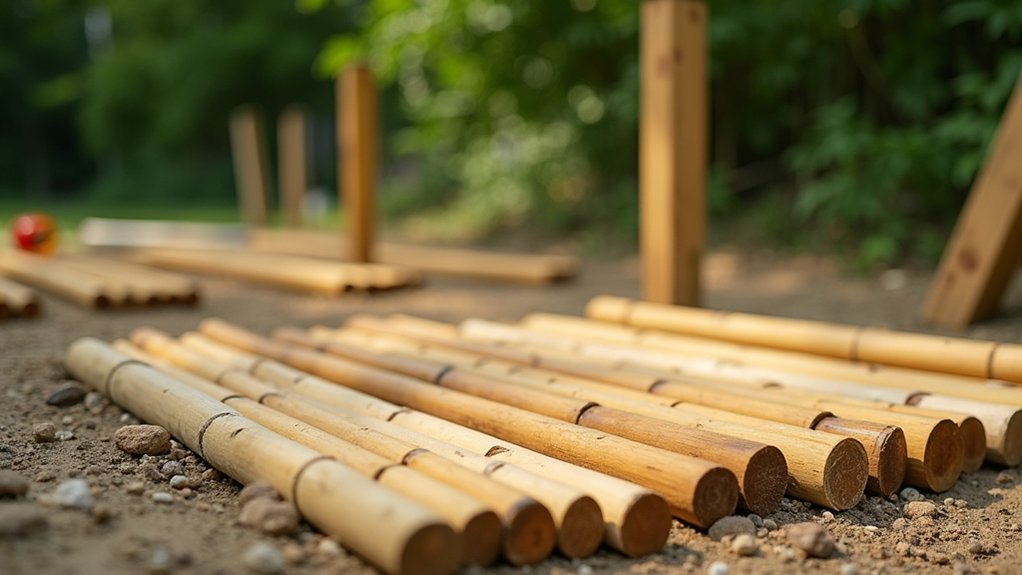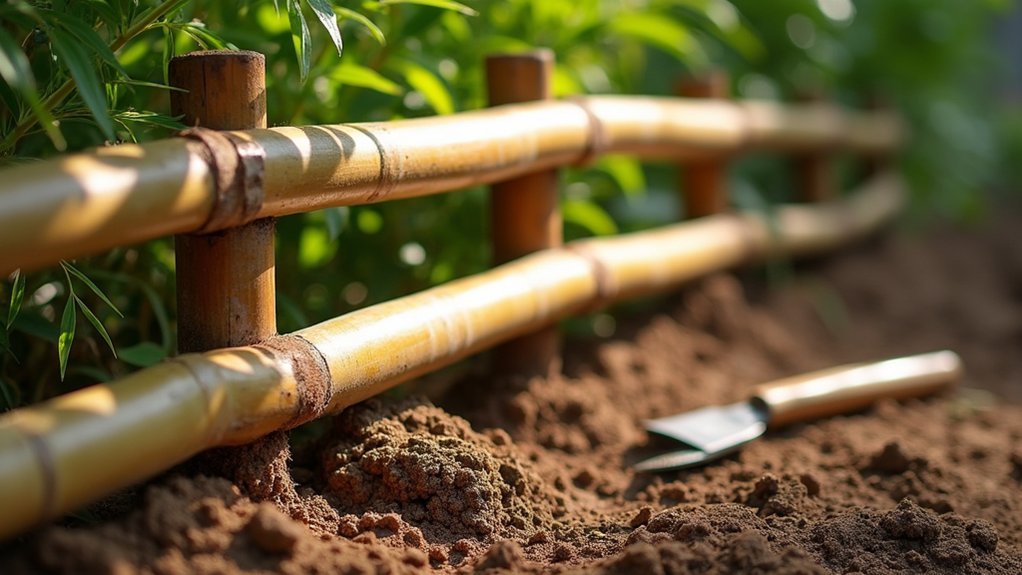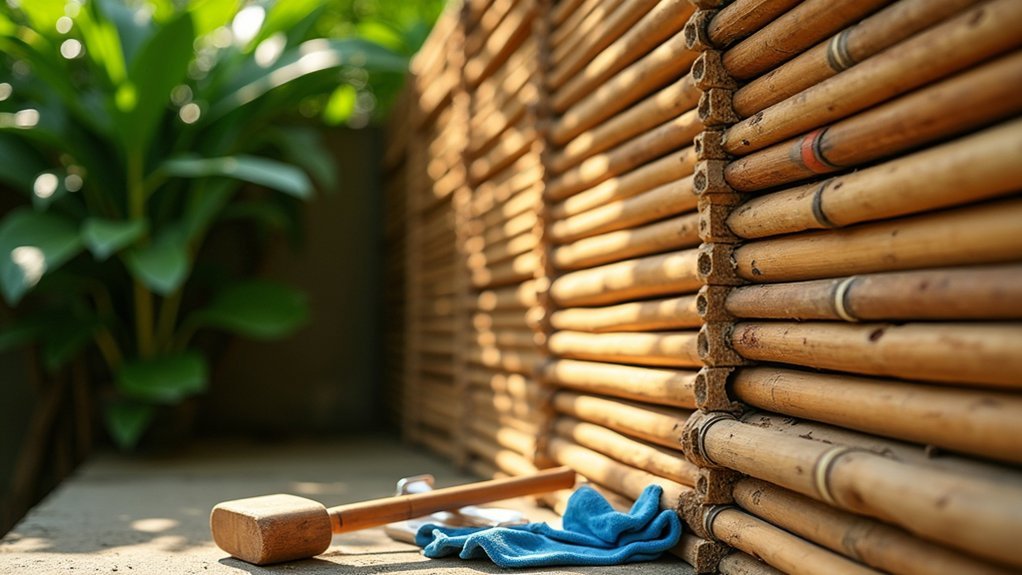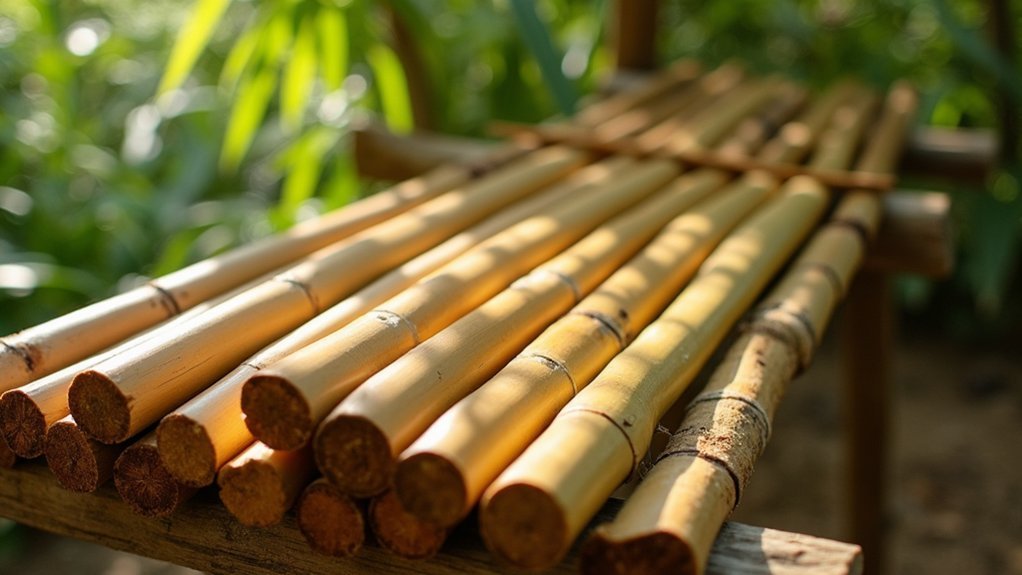To install a horizontal bamboo fence, start by mapping your fence line with stakes 6-8 feet apart. Dig post holes 12 inches deep, add gravel for drainage, and guarantee posts are level. Attach horizontal support rails using stainless steel screws, spacing them 3-4 feet apart. Mount bamboo panels to the rails, with capped ends facing upward. Apply sealant to preserve color and extend lifespan. The following guide covers everything you’ll need for a professional-looking installation.
Planning Your Bamboo Fence Project

Before breaking ground on your horizontal bamboo fence, thorough planning will save you time, money, and frustration.
Start by identifying the ideal location, considering sun exposure, wind direction, and proximity to existing structures. Measure the total length and height precisely to determine how much bamboo you’ll need.
Check local building codes and HOA guidelines to guarantee your fence meets all requirements. Decide whether you’re building for privacy, decoration, or simply marking boundaries, and plan gate locations based on your landscape flow.
Map out your fence line with stakes and string, marking post positions typically 6-8 feet apart. You’ll need to dig fence post holes at intervals of 6-7 feet to properly accommodate your fence panels.
Consider access to utilities and garden features when finalizing your layout. This preparation guarantees you’ll create a bamboo fence that’s both beautiful and practical.
Proper Post Installation Techniques
With your fence plan in hand, the next step is proper post installation—the backbone of any sturdy bamboo fence. Position vertical posts 6-7 feet apart, digging holes at least 12 inches deep. For 8-foot fences, select posts with a minimum 3-inch diameter and 1/4-inch wall thickness for sufficient strength. Structural bamboo is essential for creating a fence that will withstand environmental pressures and remain stable for years.
| Hole Preparation | Post Positioning | Backfilling |
|---|---|---|
| Add 2″ of gravel for drainage | Keep natural bamboo 2″ above ground | Compact soil every 6″ layer |
| Dig 12″+ deep depending on frost line | Use level to verify posts are plumb | Allow 24-48 hours for settling |
| Width should be 3x post diameter | Verify alignment with string guides | Consider soil-sand mix for natural stability |
Apply preservative to untreated bamboo before installation and seal cut ends with waterproof sealant. Use stainless steel or galvanized hardware for connections to prevent corrosion.
Attaching Horizontal Support Rails

Securing horizontal support rails properly creates the essential framework for your bamboo fence panels.
Select durable hardwoods like cedar or pressure-treated lumber, sized appropriately for your fence height. Space rails evenly, typically 3-4 feet apart, to distribute weight effectively.
Pre-drill holes in both rails and posts to prevent splitting, then attach using stainless steel or galvanized screws rather than nails for superior grip. This installation method ensures your fence becomes a cost-effective alternative to traditional fencing materials while maintaining durability.
Consider adding brackets for extra stability, especially on uneven terrain. Use a level to guarantee rails remain perfectly horizontal, and stretch string between posts to maintain straight alignment.
Apply a weather-resistant sealant to extend the life of your rails.
Once installed, perform a final inspection, checking that all connections are tight and secure before proceeding to attach your bamboo panels.
Mounting and Securing Bamboo Panels
The three key steps to properly mount bamboo panels begin with careful positioning against your support rails. Unroll and inspect each panel for damage before installation, ensuring dimensions match your intended coverage area.
For chain-link fences, secure panels using galvanized zip ties every 12 inches, attaching to the wire rather than the bamboo to prevent splitting. Always ensure the capped ends face upward to prevent water damage and extend the life of your bamboo fence installation.
When mounting to concrete or block walls, first install horizontal wood battens using appropriate concrete fasteners, then attach panels with deck screws.
Reinforce your installation in high-wind areas by double-layering panels or adding vertical support rails.
After installation, trim excess height with pruning shears and apply UV-protective sealant within 48 hours.
Check and tighten all fasteners after a week when the panels have settled.
Finishing Touches and Long-Term Maintenance

A properly finished bamboo fence requires attention to both aesthetic details and preventative maintenance for lasting beauty.
Apply natural sealants to preserve bamboo’s original color, and consider adding decorative elements like planters or lanterns for visual appeal. Proper edging around the fence base prevents weeds and enhances appearance.
To guarantee durability, inspect regularly for cracks, pest damage, and fungal growth. Clean with mild detergent and apply UV-resistant coatings to prevent color fading. Treat bamboo with borates for enhanced longevity, and seal joints to prevent water intrusion. Horizontal bamboo poles can create visual interest when incorporated into your fencing design.
During seasonal checks, address moisture issues promptly as they can cause warping.
Your bamboo fence isn’t just sustainable—it has a lower carbon footprint than traditional materials. With proper maintenance, you’ll enjoy its natural beauty for years to come.
Frequently Asked Questions
How Does Bamboo Fencing Perform in Extreme Weather Conditions?
Bamboo fencing performs well in extreme weather due to its natural moisture and UV resistance. You’ll find it flexes in wind without breaking, though you’ll need regular sealing to prevent rot in heavy rain.
Can Bamboo Fencing Deter Animal Intrusions Effectively?
Bamboo fencing can deter animals effectively when properly installed with sufficient height and foundation. You’ll need to evaluate your specific wildlife threats and potentially combine it with other deterrents for maximum effectiveness.
Is Bamboo Fencing Suitable for Pool Enclosures?
Yes, bamboo fencing is suitable for pool enclosures. You can use certified bamboo that meets safety requirements, offers durability in moist environments, and provides an attractive, eco-friendly option while maintaining proper pool safety standards.
How Do I Repair Damaged Bamboo Sections Without Replacing Entire Panels?
To repair damaged bamboo sections, you’ll need to clean the area thoroughly, replace individual canes, secure loose parts with stainless steel fasteners, or weave thinner bamboo through damaged areas. Apply sealant afterward for protection.
What’s the Environmental Impact Compared to Traditional Fencing Materials?
You’ll reduce your carbon footprint with bamboo fencing compared to traditional materials. It grows rapidly, absorbs more CO2, requires less water, and uses minimal chemicals during production, while remaining biodegradable and renewable.
In Summary
You’ve now completed your horizontal bamboo fence installation from planning to final touches. With proper post installation, secure attachment methods, and regular maintenance, your fence will provide beauty and privacy for years. Don’t forget to apply a weather sealant annually and check for loose poles or damage. Your eco-friendly choice not only enhances your outdoor space but adds natural elegance to your property.





Leave a Reply